story and photos by Kayte Deioma
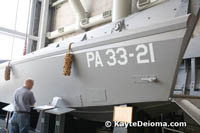 Higgins boats, also known as LCVPs (Landing Craft, Vehicle, Personel), are credited with allowing the allies to win World War II. They’re also the reason that you’ll find theNational World War II Museum in New Orleans. These amphibious vessels were modeled after the Eureka, a flat-bottomed boat designed by New Orleanian Andrew Jackson Higgins to navigate the swamps and bayous of Louisiana by reversing off land banks when they ran aground. The modified version, with a ramp to offload its cargo of one jeep and 12 soldiers, was one of half a dozen military vessels designed and built by Higgins Industries in New Orleans.
Higgins boats, also known as LCVPs (Landing Craft, Vehicle, Personel), are credited with allowing the allies to win World War II. They’re also the reason that you’ll find theNational World War II Museum in New Orleans. These amphibious vessels were modeled after the Eureka, a flat-bottomed boat designed by New Orleanian Andrew Jackson Higgins to navigate the swamps and bayous of Louisiana by reversing off land banks when they ran aground. The modified version, with a ramp to offload its cargo of one jeep and 12 soldiers, was one of half a dozen military vessels designed and built by Higgins Industries in New Orleans.
By the end of the war, the company had produced over 20,000 amphibious troop and equipment transporters that allowed the rapid deployment of personnel from the beaches of Normandy to islands in the South Pacific. President Eisenhower later proclaimed: “Andrew Jackson Higgins is the man who won the war for us.”
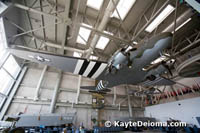 A replica of an LCVP, built according to the original plans, is on display in the Louisiana Memorial Pavilion at the National WWII Museum. The relatively small craft is overshadowed by the Douglas C-47 hanging overhead in the cavernous space. Other military vehicles on display in the Pavilion include a US tank, and jeeps, a German motorcycle and Howitzer, and a Supermarine Spitfire airplane from the British Royal Air Force.
A replica of an LCVP, built according to the original plans, is on display in the Louisiana Memorial Pavilion at the National WWII Museum. The relatively small craft is overshadowed by the Douglas C-47 hanging overhead in the cavernous space. Other military vehicles on display in the Pavilion include a US tank, and jeeps, a German motorcycle and Howitzer, and a Supermarine Spitfire airplane from the British Royal Air Force.
This is just the big stuff that wouldn’t fit inside the museum galleries. You could spend all your time admiring the transport vehicles and the temporary exhibits above them and completely miss the fact that the real exhibits are through a doorway to the right of the cashier, past the restrooms, gift shop and coffee shop, and up the stairs or elevator.
As someone who never did very well in history and can never remember the dates of important historical events, I have to say that they’ve done a good job organizing a very complex time into logical chunks with clear timelines. Personal stories, oral histories and artifacts, both rare and common, help bring the period to life.
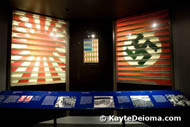 There’s a clear progression through the galleries. You begin with the build up to war and the imbalance of military forces. A graphic display using miniature soldiers against national flags shows how under-armed the American military was compared to the massive build up of forces in Germany and Japan. Even Italy had three times the military might of the U.S before the United States was forced into the war.
There’s a clear progression through the galleries. You begin with the build up to war and the imbalance of military forces. A graphic display using miniature soldiers against national flags shows how under-armed the American military was compared to the massive build up of forces in Germany and Japan. Even Italy had three times the military might of the U.S before the United States was forced into the war.
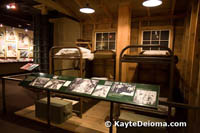 America Goes to War shows how the military buildup in America affected the people at home, from the implementation of the draft to women and minorities landing higher paying jobs in factories. Stacks of tires and piles of artillery shells demonstrate how sacrifices at home supplied the war effort. You can see the 1943 pennies made of steel so that the copper could be used for communication wire on the battle fields.
America Goes to War shows how the military buildup in America affected the people at home, from the implementation of the draft to women and minorities landing higher paying jobs in factories. Stacks of tires and piles of artillery shells demonstrate how sacrifices at home supplied the war effort. You can see the 1943 pennies made of steel so that the copper could be used for communication wire on the battle fields.
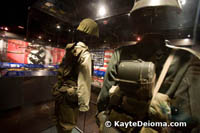 In the War in Europe section you can compare the uniforms of American and German soldiers as well as the weapons with which they were armed. You can also take a look inside a GI’s pockets to see what he would have been carrying, from his toothbrush and extra socks to shaving cream and toilet paper.
In the War in Europe section you can compare the uniforms of American and German soldiers as well as the weapons with which they were armed. You can also take a look inside a GI’s pockets to see what he would have been carrying, from his toothbrush and extra socks to shaving cream and toilet paper.
Operation Overlord was the strategy that landed 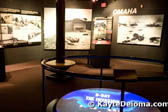 150,000 troops on the shores of Normandy in France on June 6, 1944 in what is now known as D-Day. This military reference to the undisclosed day an operation is to be implemented actually applies to every operation, but in common parlance, it refers to the execution of Operation Overlord. A tableau shows the density of ships and aircraft crossing the English Channel.
150,000 troops on the shores of Normandy in France on June 6, 1944 in what is now known as D-Day. This military reference to the undisclosed day an operation is to be implemented actually applies to every operation, but in common parlance, it refers to the execution of Operation Overlord. A tableau shows the density of ships and aircraft crossing the English Channel.
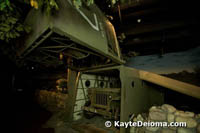 The strategy is laid out in personal stories of the assault by American, British and Canadian troops on five different French beaches. The stories of Omaha Beach, where American soldiers met the greatest German resistance, are accompanied by the compelling photos of the onslaught by the famous war photographer Robert Capa.
The strategy is laid out in personal stories of the assault by American, British and Canadian troops on five different French beaches. The stories of Omaha Beach, where American soldiers met the greatest German resistance, are accompanied by the compelling photos of the onslaught by the famous war photographer Robert Capa.
The Pacific War similarly shows the equipment and weapons used by U.S. GIs compared to their Japanese counterparts. Examples of war propaganda show the racism on both 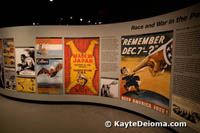 sides of the battle. Photos and stories illustrate the challenging physical conditions faced by soldiers and the heavy losses due to disease. A series of D-Day panels shows a timeline of D-Days for major operations in the Pacific theatre. TheAtom Bomb display is located at the bend in the hallway leading to Victory in the Pacific around the corner.
sides of the battle. Photos and stories illustrate the challenging physical conditions faced by soldiers and the heavy losses due to disease. A series of D-Day panels shows a timeline of D-Days for major operations in the Pacific theatre. TheAtom Bomb display is located at the bend in the hallway leading to Victory in the Pacific around the corner.
Audio oral histories are scattered throughout the museum. There are also several short films playing in small theaters near the relevant exhibits. The Road to War sets up the background.Decision to Go and Normandy to Berlin give glimpses of the European front. The Battle of Midwayand the Battle of the Philippine Sea and Leyte Gulf show the war in the Pacific. There are also two 45 minute films that alternate in the Malcolm Forbes Theater, D-Day Remembered ( Normandy) and Price for Peace (the Pacific).
The museum also hosts interesting temporary exhibits upstairs in the Louisiana Memorial Pavilion above the airplanes. Some are traveling exhibits and some are thematic exhibits from their own collection.
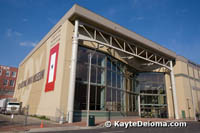 If you read everything and watch the videos, you could spend all day. There are plenty of exhibits that are relatively self-explanatory without reading all the informational panels if you’re pressed for time, or not a big museum reader. If you want to do the reading at home before you go, check out the history section of the museum’s website. It provides much of the information on the extensive exhibit panels. Then you can spend your museum time studying the artifacts and photos.
If you read everything and watch the videos, you could spend all day. There are plenty of exhibits that are relatively self-explanatory without reading all the informational panels if you’re pressed for time, or not a big museum reader. If you want to do the reading at home before you go, check out the history section of the museum’s website. It provides much of the information on the extensive exhibit panels. Then you can spend your museum time studying the artifacts and photos.
The National WWII Museum
945 Magazine Street (Entrance on Andrew Higgins Drive)
New Orleans, LA 70130
(504) 527-6012
www.nationalww2museum.org
The National WWII Museum is included in the discount New Orleans Pass.
